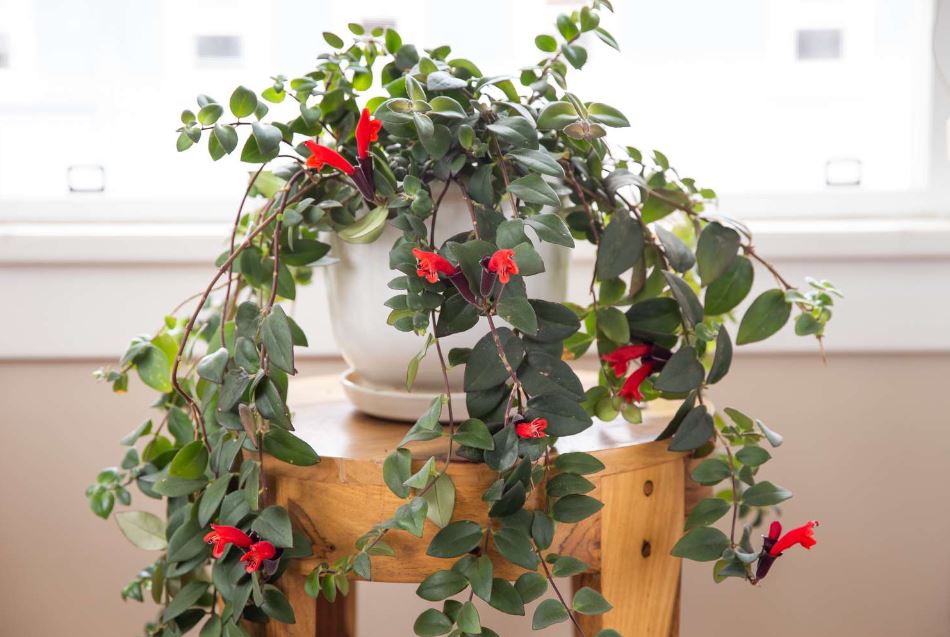
The Aeschynanthus genus belongs to the Gesneriaceae family, which is known for including many popular indoor plants like the African violet. The species within this genus primarily originate from the tropical and subtropical regions of Southeast Asia, including countries like Malaysia, Indonesia, Thailand, and the Philippines.
In the wild, many Aeschynanthus species are epiphytic, meaning they grow on trees in the humid rainforests, although they can also be lithophytic, growing on rocks. They thrive in environments where they can receive dappled sunlight and high humidity but are protected from direct harsh sunlight.
These flowers are tubular, often appearing in clusters, and emerge from a calyx that resembles a lipstick tube, hence “Lipstick Plant.” The colors typically range from red to orange, but there are also varieties with yellow, green, or even purplish flowers. They usually bloom in the warmer months, but with the right indoor conditions, some might bloom intermittently throughout the year.
The leaves of Aeschynanthus plants are generally thick, waxy, or leathery to help retain moisture. They can vary from ovate to lanceolate in shape, often with a glossy surface. Some species exhibit variegation or marbling, which adds to their ornamental value.
Cultivation
- Light: They prefer bright, indirect light. Direct sunlight can scorch their leaves, while too little light can prevent blooming.
- Watering: They like to be kept moist but not waterlogged. Overwatering can lead to root rot, while under-watering can cause the plant to drop buds or flowers.
- Humidity: High humidity is preferred, which mimics their natural tropical environment. Misting or using a humidity tray can help in drier climates.
- Temperature: They thrive in temperatures between 65°F to 80°F (18°C to 27°C) but can tolerate a slight drop at night.
- Soil: A well-draining soil mix, often containing peat, perlite, or orchid bark, suits them well given their epiphytic nature.
Types of Lipstick Plants (Aeschynanthus spp.), Description
Aeschynanthus radicans
Often the classic “Lipstick Plant,” it has bright red tubular flowers emerging from a dark calyx, resembling lipstick coming out of its tube. The leaves are waxy and green, sometimes with a hint of red.
Aeschynanthus lobbianus
Known for its creamy-white flowers with a touch of red or purple at the base. The leaves are somewhat rounded and have a lighter green color compared to other species.
Aeschynanthus pulcher
This species has striking scarlet flowers with yellow throats. Its leaves are thick, leathery, and often have a burgundy underside, adding to its ornamental appeal.
Aeschynanthus longicaulis
Features flowers that are more orange-red, with longer stems than some other varieties, making it excellent for hanging baskets. The foliage can have a marbling effect.
Aeschynanthus marmoratus
Unique for its foliage, which has a marbled, veined pattern in dark and light green. The flowers are greenish-yellow with a reddish-brown calyx.
Aeschynanthus speciosus
One of the largest in the genus, with big, bright orange flowers and robust, fleshy leaves. It’s quite showy and often used in tropical garden displays.
Aeschynanthus tricolor
This plant has smaller, but very vibrant red flowers with black and yellow markings, making it quite distinctive. The leaves often have a reddish tint.
Aeschynanthus hildebrandii
Known for its less common, more subdued green flowers with red tips. Its leaves are elongated and have a pointed tip, with a lighter vein pattern.
Aeschynanthus micranthus
A smaller species with tiny, delicate red flowers. Its leaves are also small, giving it a dainty overall appearance.
Aeschynanthus parvifolius
As the name suggests, it has smaller leaves than many of its relatives. The flowers are a deep red with a yellow throat.
Aeschynanthus humilis
A dwarf variety with bright red flowers. Its compact nature makes it suitable for smaller spaces.
Aeschynanthus longiflorus
It boasts longer flowers than most, which are typically a deep red color. The foliage can be quite dark green, almost appearing black in low light.
Aeschynanthus fulgens
Known for its brilliant display of flowers that can almost cover the plant with their red-orange hue. The leaves are thick and have a slight sheen.
Aeschynanthus ‘Rasta’
A cultivar with curly or wavy leaves, adding texture. The flowers are typical lipstick plant red but might appear in greater numbers.
Aeschynanthus ‘Twister’
Similar to ‘Rasta,’ but with even more pronounced curls in the foliage, making it visually intriguing even when not in bloom.
Aeschynanthus ‘Mona Lisa’
This cultivar has a more subdued flower color, often a dark red with a nearly black calyx, and its leaves are broad with a nice gloss.
Aeschynanthus ellipticus
Featuring more oval, pointed leaves and flowers that can be a lighter shade of red or even orange.
Aeschynanthus evrardii
A less common species, with flowers that have a unique purplish tint at the edges of the red petals.
Aeschynanthus siphonanthus
Known for its flowers which seem to be “siphoned” or tubular to an extreme, often appearing more elongated than other species.
Aeschynanthus japhrolepis
Has a subtle beauty with lighter red or pink flowers and leaves with distinctive silver veins.
Aeschynanthus ‘Hot Flash’
A hybrid with particularly vibrant flowers, often with an intense orange-red color, designed to be a showstopper in any collection.